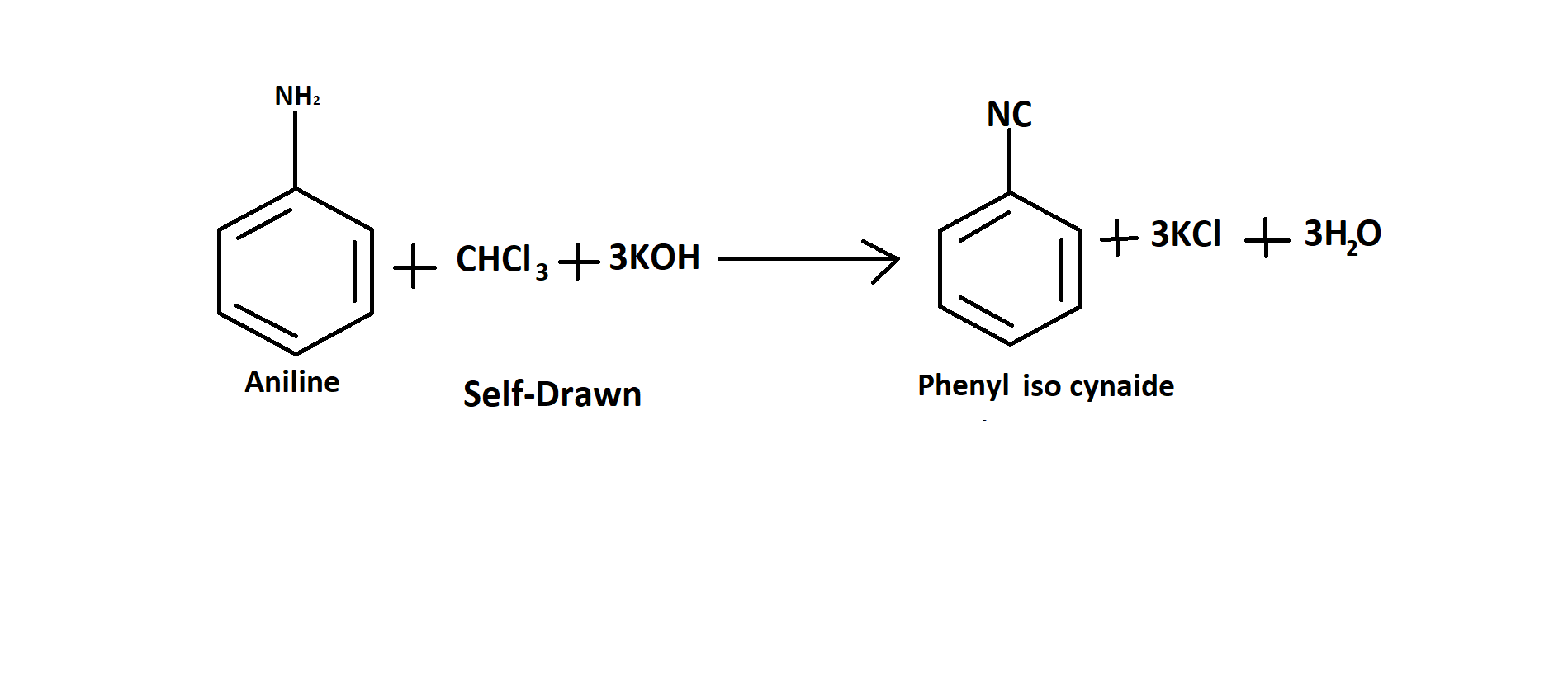
Chloroform when treated with aniline and alcoholic KOH gives:
a) phenyl cyanide
b) iso-phenyl cyanide
c) chlorobenzene
d) phenol
Answer
218.7k+ views
Hint The reaction of Chloroform which is treated with aniline and alcoholic KOH. Look that it is the isocyanide test. From the name we will guess the isocyanide is the product because in between the reactants nobody is isocyanide.
Complete step-by-step solution
The reaction of Chloroform with aniline and alcoholic KOH is called isocyanide test because the product is an iso-cyanide. Let’s know something more about the isocyanide test.
Aniline is an aromatic amine. It is a precursor to various drugs, dyes, and plastics. It is also a pollutant. Aniline is toxic, and it can be harmful to the environment.
The isocyanide test can be used to determine the presence of aniline in a sample. The test uses a reagent that reacts with aniline to form a blue colour. The reaction is not specific for aniline, so other compounds that contain aniline-like structures can also produce a blue colour. Only, primary aliphatic and aromatic amines provide it.
The isocyanide test is a quantitative test. The test can be used to determine the concentration of aniline in a sample. The test is also sensitive to low concentrations of aniline.
Now let’s see the product of the reaction of aniline and chloroform with alcoholic KOH. Obviously, the product is an isocyanide that iso-phenyl cyanide. Let's see the reaction now.

Now let's see the mechanism of the reaction. Chloroform is the first dehydrohalogenation (hydrogen halide is removed from a specific substrate) to produce dichlorocarbene intermediate. This intermediate of the dichlorocarbene is very reactive. The main amine's nucleophilic nitrogen is attacked by the electrophilic dichlorocarbene. Isonitrile is created as a result of the hydrochloric acid being eliminated. Below is a diagram that shows how the carbylamine reaction works.

So, option b is the correct option.
Note: The reaction of Chloroform with aniline and alcoholic KOH is called isocyanide test because the product is an iso-cyanide. Here, the product is an isocyanide that iso-phenyl cyanide. Only, primary aliphatic and aromatic amines provide it.
Complete step-by-step solution
The reaction of Chloroform with aniline and alcoholic KOH is called isocyanide test because the product is an iso-cyanide. Let’s know something more about the isocyanide test.
Aniline is an aromatic amine. It is a precursor to various drugs, dyes, and plastics. It is also a pollutant. Aniline is toxic, and it can be harmful to the environment.
The isocyanide test can be used to determine the presence of aniline in a sample. The test uses a reagent that reacts with aniline to form a blue colour. The reaction is not specific for aniline, so other compounds that contain aniline-like structures can also produce a blue colour. Only, primary aliphatic and aromatic amines provide it.
The isocyanide test is a quantitative test. The test can be used to determine the concentration of aniline in a sample. The test is also sensitive to low concentrations of aniline.
Now let’s see the product of the reaction of aniline and chloroform with alcoholic KOH. Obviously, the product is an isocyanide that iso-phenyl cyanide. Let's see the reaction now.

Now let's see the mechanism of the reaction. Chloroform is the first dehydrohalogenation (hydrogen halide is removed from a specific substrate) to produce dichlorocarbene intermediate. This intermediate of the dichlorocarbene is very reactive. The main amine's nucleophilic nitrogen is attacked by the electrophilic dichlorocarbene. Isonitrile is created as a result of the hydrochloric acid being eliminated. Below is a diagram that shows how the carbylamine reaction works.

So, option b is the correct option.
Note: The reaction of Chloroform with aniline and alcoholic KOH is called isocyanide test because the product is an iso-cyanide. Here, the product is an isocyanide that iso-phenyl cyanide. Only, primary aliphatic and aromatic amines provide it.
Recently Updated Pages
The hybridization and shape of NH2 ion are a sp2 and class 11 chemistry JEE_Main

What is the pH of 001 M solution of HCl a 1 b 10 c class 11 chemistry JEE_Main

Aromatization of nhexane gives A Benzene B Toluene class 11 chemistry JEE_Main

Show how you will synthesise i 1Phenylethanol from class 11 chemistry JEE_Main

The enolic form of acetone contains a 10sigma bonds class 11 chemistry JEE_Main

Which of the following Compounds does not exhibit tautomerism class 11 chemistry JEE_Main

Trending doubts
JEE Main 2026: Application Form Open, Exam Dates, Syllabus, Eligibility & Question Papers

Derivation of Equation of Trajectory Explained for Students

Hybridisation in Chemistry – Concept, Types & Applications

Understanding the Angle of Deviation in a Prism

Understanding Collisions: Types and Examples for Students

Understanding Atomic Structure for Beginners

Other Pages
NCERT Solutions For Class 11 Chemistry Chapter 7 Redox Reaction

JEE Advanced Marks vs Ranks 2025: Understanding Category-wise Qualifying Marks and Previous Year Cut-offs

Thermodynamics Class 11 Chemistry Chapter 5 CBSE Notes - 2025-26

NCERT Solutions ForClass 11 Chemistry Chapter Chapter 5 Thermodynamics

Equilibrium Class 11 Chemistry Chapter 6 CBSE Notes - 2025-26

How to Convert a Galvanometer into an Ammeter or Voltmeter




